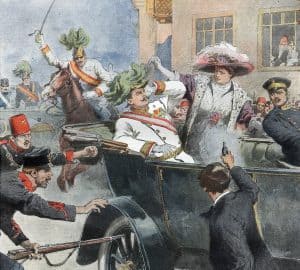One of the most famous sayings to come out of the First World War was that the British infantrymen on the Western Front were “lions led donkeys.” It is an easy position to take. A cursory view will show you that the Allies were attacking the German trenches again and again over the same ground, losing thousands upon thousands of men for just yards of ground. It is one of the great tragedies in military history. The blame is often placed upon the British commanders, who are accused of stupidly wasting their men in frontal attacks because they could think of nothing better to do. The reality is more complicated.
The Western Front problem was not a simple nut to crack. The war in the west quickly turned into a stalemate, with trenches stretching from neutral Switzerland, through France and Belgium all the way to the English Channel. They could not be flanked, and simple frontal charges were clearly useless against trenches, barbed wire, machine guns, and modern artillery bombardments. As the war dragged on and the casusalty bills lengthened, many Allied leaders were concerned it was the generals’ fault. David Lloyd-George, the British Prime Minister, wrote:
The Cabinet must regard themselves as trustees for the fine fellows that constitute our army. They are willing to face any dangers, and they do so without complaint, but they trust to the leaders of the nation to see that their lives are not needlessly thrown away, and that they are not sacrificed on mere gambles which are resorted to merely because those who are directing the War can think of nothing better to do with the men under their command. … A mere gamble would be both a folly and a crime.1
It is easy to underestimate the challanges that the Allies faced on the Western Front. The generals had spent long careers in the military, fighting and training with certain presuppositions in mind. World War One smashed many of those in just weeks, and they were having to relearn tatics and strategy while fighting the war.

The idea that the Allies were doing the same thing over and over again is a gross simplification. Their tactics to break through the German lines were constantly evolving. As the weeks and months stretched on, they were learning how to use air reconnaissance, how to use artillery effectively, eventually resulting in the creeping bombardment, developing tanks and breaking down the infantry into specializations to operate more effectively. Unfortunately, all these things could not be developed without bloody trial and error. Thousands of men fell, but lessons were learned which could be applied to give the next attack a chance of success. By the end of the war, an assault on trenches looked far different than only a few years before.

Another important aspect is that the German lines that they were attacking in 1914 were not the same as those in 1918. They were constantly improving their works, digging them deeper, adding further lines behind them, and developing new plans to counter a breakthrough. One set of Allied tactics that was bloodily defeated may have won great success a few months before, when the German defenses were weaker. When the Allies planned to make an attack, it would take weeks or months to prepare for tens of thousands of men to go over the front. The Western Front became a technological and tactical race for whether the assaults could get good enough to beat the constantly improving defensive works.
For these reasons, it is inappropriate to say that the heroic British soldiers were slaughtered en-masse by inept commanders. While there certainly were examples of incompetence, the Allied generals worked hard to overcome the difficult and constantly changing challenges that they faced.
1. The Great War, by Peter Hart p. 352





I have not read Mr. Hart’s book but I do know a fair bit about the “War to End Wars”. My mother was born on August 18th 1915 and my grandfather did two tours of service in the “Great War”.
My conclusion…British Lions, dutiful British subjects, brilliant and brave young college boys, tough miners, simple honest tradesmen and factory workers were led by donkeys for lack of an even more derogatory term.
The war was carried out from the Somme to Gallipoli in as dim-witted a fashion as could be possible. Men’s lives were indeed thrown away uselessly on every front. The Serbs made more progress in a few days than the French and British in years of fighting! The British cabinet, the generals and colonels and majors seemed to think they were fighting the Peninsular War, ignoring even lessons learned in Crimea (as the Russians and Americans did lessons learned by the British in Afghanistan or the Americans those taught the French in Vietnam!). Above all they forgot technology…that the human body is no match for machine guns and running across open ground can not be done before an entrenched enemy well provisioned with guns and bullets and shells.
I could go on and on with details and examples, but the subject sickens me. Britain and America lost a countless number of their bravest and best…a loss from which Britain has never recovered…the finest intellects, the bravest souls…lost in France in two wars, in Spain fighting for a lie…men whose children and grandchildren would have made Britain a far better place than it is today.
The conclusion you make here troubles me. The British Lion died thanks to the donkeys which led her in 2 world wars…and since.